Laurel Tree (Sweet Bay): Leaves, Flowers, Fruit (Pictures) – Identification Guide
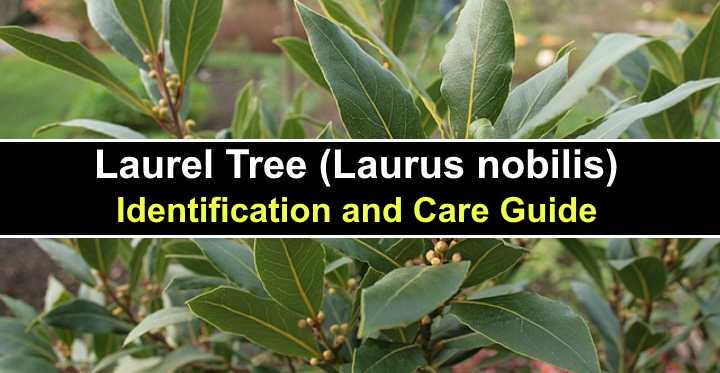
The laurel tree is an evergreen shrub-like tree with aromatic, dark-green, lance-shaped leaves, clusters of pale-yellow flowers, and small black berries. Also called sweet bay, the bushy plant thrives in warm climates as a small tree, potted shrub, or evergreen hedge. This bushy shrub is easy to grow and makes a great addition to a garden landscape or container garden.
This article covers everything you need to know about growing the versatile laurel tree. You’ll also learn how to identify the Laurus nobilis (laurel) tree. In addition, pictures of its leaves, fruits, and flowers will help determine whether this shrub is suitable for growing in your garden.
About the Laurel Tree (Bay Laurel)
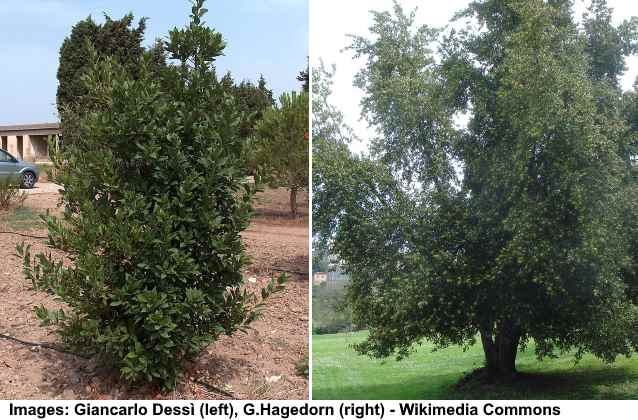
Young laurel shrub (left), and Laurus nobilis growing as a tree (right)
The laurel tree (Laurus nobilis) is an evergreen flowering plant in the family Lauraceae. The small tree or large multi-stemmed shrub is native to the Mediterranean region. Planted in full sun or partial shade, a laurel tree has a pyramidal shape and grows 23 – 60 ft. (7 – 18 m) tall.
Dense, thick leathery foliage characterizes the laurel tree. The leaves are described as lanceolate or narrowly ovate. And it’s the leaves that the laurel tree is most famous for.
Due to its Mediterranean origins, a laurel tree is suitable for growing in USDA zones 8 through 10. However, if you live in temperate climates, the aromatic shrub grows as an excellent container plant. This allows you to bring it indoors to protect it from frost.
Laurel leaves, or bay leaves, are commonly used to flavor many soups, stews, and sauces. The aromatic leaves add a distinctive herbal, slightly floral taste with minty overtones to dishes. However, the dried bay leaves are never eaten whole as they are stiff and sharp and could pose a choking risk.
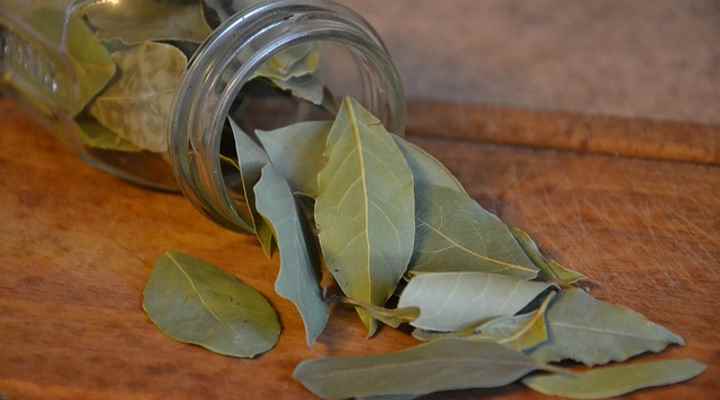
Dried bay leaves
Laurus nobilis has a conical habit that develops a rounded or pyramidal appearance. The shrub-like tree’s glossy olive green, smooth leaves grow abundantly, creating a dense leafy plant. Thanks to its resilience, the laurel tree can be pruned easily to limit its height, create a formal hedge, or use in topiary.

Laurel topiary tree
Common names for Laurus nobilis include bay laurel, sweet bay, and Grecian laurel. Additionally, the tree is also called true laurel. This is because several unrelated plants and shrubs also have the common name laurel: English laurel or cherry laurel (Prunus laurocerasus), and skip laurel.
The laurel tree has long been associated with power and victory. In ancient Greece and Rome, wreaths of laurel leaves were presented to the winners. Also, Caesars and emperors often had a crown of laurel leaves. Interestingly, the term baccalaureate, or bachelor’s degree, comes from the word for laurel berry, baccalaureus.
Additionally, the term “rest on your laurels” comes from encouraging champions who received the laurel wreath not to become complacent.
Laurel Leaves
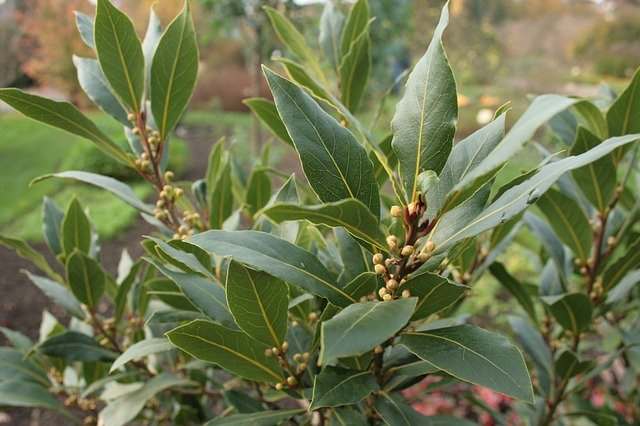
Laurel leaves
A laurel tree leaf is identified as a leathery, aromatic, smooth dark bluish-green blade with a shiny texture. The pointed lanceolate laurel leaves measure 2” – 5” (2.5 – 12 cm) long and up to 1.6” (4 cm) wide. Laurel leaves have a smooth but sometimes wavy margin.
Laurel leaves are classified as simple, ovate-shaped leaves that grow on a short petiole (stem). The smooth green glossy leaves also have noticeable yellow veins. The evergreen leaves grow alternately on stems. After drying, laurel leaves become brittle and easily break.
Laurel Flowers
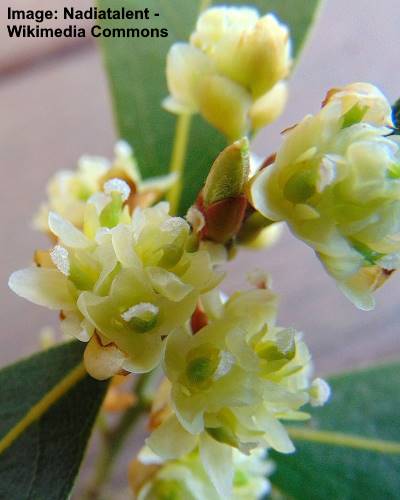
Laurel flowers
Flowers growing on a laurel tree are tiny pale, yellowish-green flowers that grow in dense clusters at the ends of branches and beside leaves. Laurel trees bloom in spring, where the masses of golden-yellow flowers contrast with the shiny dark-green leaves. The small yellow clusters measure 0.4” (1 cm) in diameter.
Laurel Fruit
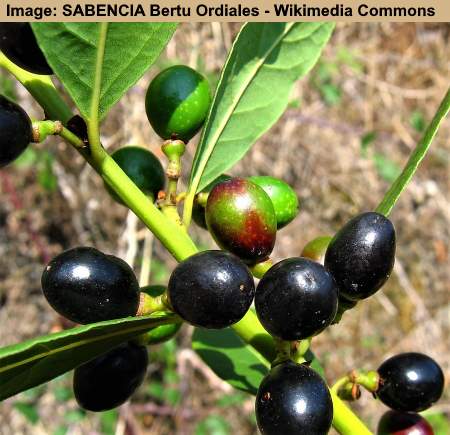
Laurel fruit
Fruit from a laurel tree is a shiny purple-black drupe that resembles a berry. The glossy black laurel berries measure about 0.4” to 0.5” (1 – 1.2 cm) in diameter. Fruit from Laurus nobilis is not poisonous; however, they are generally not used for culinary purposes.
It’s important to note that other plants with the common name laurel produce poisonous berries. For example, the leaves and berries from cherry laurel (Prunus laurocerasus) and mountain laurel (Kalmia latifolia) are toxic and should never be eaten.
How to Identify Laurel Tree
The easiest way to identify a bay laurel tree is by its shiny, smooth, dark-green lanceolate leaves. Leaves grow densely on laurel trees, and the plant has a recognizable pyramidal crown. Clusters of small yellow flowers decorate the bushy shrub in spring, followed by dark purple-black berries.
Bay Laurel Hedge
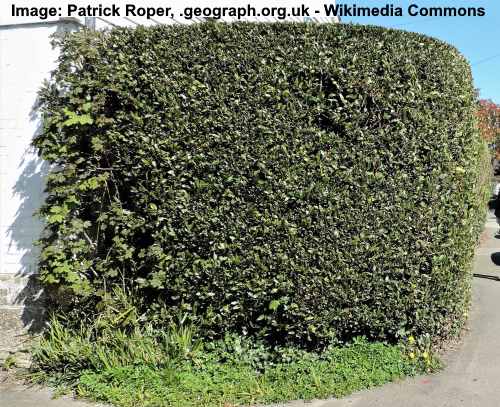
Bay laurel hedge
Bay laurel is an evergreen tree with a shrub-like habit, ideal for growing as a hedge, privacy screen, or living fence. The bushy multi-trunked shrub has dense foliage that stays green throughout the year. Planting laurel shrubs in a row creates a beautiful hedge to enhance privacy and protection in your backyard.
A slow-growing hedge, bay laurel grows around 8” (20 cm) each year, and light pruning can help maintain its height at 1 to 3 ft. (0.3 – 1 m). This low-maintenance hedge needs hardly any attention during the winter months. You only need to cut back dead stems when they appear.
Bay laurel trees have a spread of 12 to 15 ft. (3.6 – 4.5 m) wide. To create a dense laurel hedgerow, space the plant about 12 ft. (3.6 m) apart. However, to get your hedge to fill out faster, you could leave 6 ft. (1.8 m) between planted laurel shrubs. Then when the foliage touches, cut out every second plant.
How to Care for Bay Leaf Tree
To care for a bay laurel tree, grow the bay leaf plant in full sun to partial shade. Water the bay tree regularly during the summer to keep the ground moist but never soggy. Laurel trees grow in almost any soil type. Add some organic compost to the root area every spring.
Growing Bay Laurel Tree in Pots
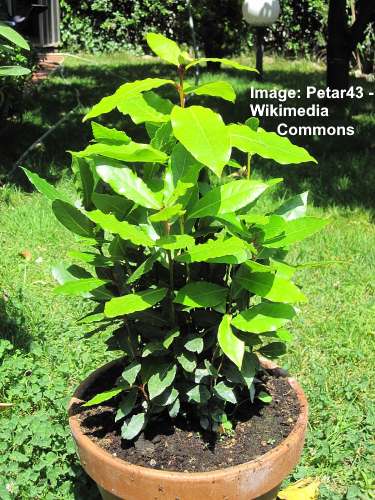
Potted laurel plant
To grow a potted bay leaf tree, choose a clay pot 12” (30 cm) wide and grow the laurel tree in a mixture of potting soil, compost, and perlite. Water whenever the top 2” (5 cm) of soil is dry, pouring enough water until it drains from the pot’s drainage holes.
Bay leaf trees are ideal plants for growing in containers. The small leafy tree requires little maintenance. The only care a bay laurel plant in a container needs is plenty of sunlight and adequate watering.
Harvesting Sweet Bay Leaves
Pick bay laurel leaves at any time to use in cooking; however, midsummer is best. To ensure full flavor, harvest leaves from a sweet bay tree when it’s at least two years old. You can use the leaves fresh, or you can dry them. Drying bay leaves gives them a more intense, savory flavor.
How to Dry Bay Leaves
To dry bay leaves, rinse the harvested leaves under cool water and then pat dry. Spread the aromatic leaves on a layer of parchment paper and leave them in a warm, well-ventilated room away from direct sunlight. Dried bay leaves should be ready for use in two weeks.
To speed up the drying process, you can use a food dehydrator or a warm oven. For example, it should take two hours to dry bay leaves in an oven at 200°F (100°C).
Using Bay Leaf (Laurus nobilis) in Cooking
Using bay leaf as an aromatic spice is popular in Mediterranean cooking. Usually, you add a whole bay leaf to stews, soups, braises, and sauces. The leaf should remain in the pot for the entire cooking time. Then before serving, remove the leaf.
Dried bay leaves are stiff and sharp and can damage your mouth if you eat them. Also, eating fresh bay leaves is unappetizing because they have a sharp, bitter taste. However, adding a bay leaf when cooking food releases a floral aroma that resembles thyme and oregano.
Laurel Tree (Sweet Bay) Care Guide
Let’s look in detail at growing a laurel tree in your garden or container.
Where to Plant Laurel Tree
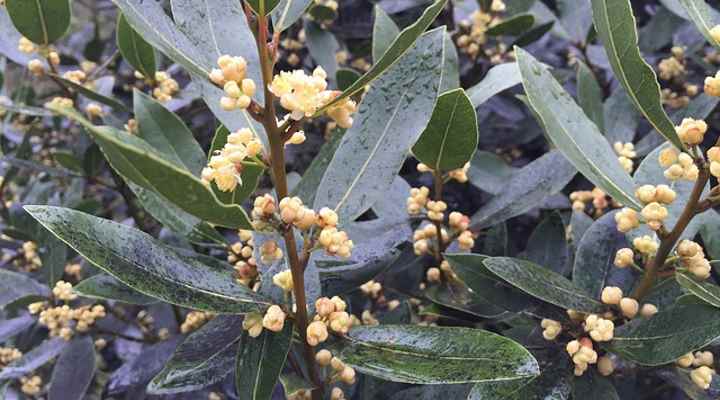
Laurel trees/shrubs grow best in full sun and well-draining soil but can tolerate partial shade
The best place to plant a laurel tree is in an area with full sun and free-draining soil. Sweet bay laurels thrive when they get at least six hours of sunshine daily. However, the evergreen plant will grow just as well in partial shade. In colder regions, the laurel tree needs protection from winds in cold weather.
The best soil for bay laurels should have good levels of organic matter such as peat moss, composted manure, leaf mold, and humus. However, bay laurel adapts well to many soil types. But the most important factor when planting a bay laurel tree is that the ground is well-draining.
How to Plant Bay Laurel Tree
To plant a bay laurel tree outdoors, choose a sunny location sheltered from the wind, leaving at least 6 feet (1.8 m) of space from structures. Then dig a hole the same depth as the root ball and twice as wide. Next, place the tree in the hole and backfill the hole with organically-rich soil and water well.
How to Water Bay Leaf Tree
Water a bay laurel tree often enough to keep the soil moist without becoming waterlogged. Typically, bay laurels prefer watering once a week during the growing season. However, in hot weather, you should water it more often. During winter dormancy, the laurel tree only requires occasional watering.
A feature of a bay laurel tree is that it has shallow roots. Because of this, the shrub-like tree needs regular watering. This also means you should exercise care weeding around the plant to avoid damaging the roots. Adding a layer of mulch can help to improve a bay laurel tree’s growth.
Sweet Bay Tree — Temperature and Humidity Requirements
Bay laurel trees are native to the warm climate of the Mediterranean region. Therefore, the bushy shrub thrives in warm weather. Being hardy to zone 8 means that the heat-loving laurel plant doesn’t tolerate temperatures below 20°F (-7°C).
If you live in zone 7 and below, you should overwinter a bay laurel shrub indoors. Average room temperatures are perfect for healthy growth. However, the drier household air can cause humidity issues for a potted laurel plant.
To increase indoor humidity for a sweet bay plant, place the pot on a pebble tray half-filled with water. Alternatively, you can use a room humidifier to increase air moisture and prevent leaves from dropping.
Should you mist bay laurel tree leaves? Misting and wiping the leaves with a clean cloth will help clean the leaves. However, it won’t help address low humidity issues when growing a bay laurel indoors.
Bay Laurel Tree Growth Rate
Bay laurel is a slow-grower that only grows around 4” – 8” (10 – 20 cm) per year. Growing the plant in full sun, giving it enough water, and applying fertilizer will ensure the fastest growth. Therefore, it takes many years for a bay laurel to reach its mature height.
How to Fertilize Laurel Tree
Bay laurel trees benefit from regular fertilization during the growing season. Therefore, it is recommended to apply a general-purpose fertilizer twice a month during the growing season. However, to encourage vigorous leaf growth, you could use a diluted tree fertilizer with an NPK rating of 24-8-16.
Alternatively, add slow-release granules to compost and apply to the root area every spring.
Potted bay laurel trees usually require fertilizing every two weeks. It’s best to apply half a teaspoon of a nitrogen-rich fertilizer for every gallon (3.7 l) of water. As with all potted plants, hold off fertilizing during dormancy.
Pruning Bay Laurel Tree
Prune a bay laurel tree in spring to encourage vigorous growth. Typically, it would be best if you pruned up to one-third of the tree’s growth. However, bay laurel trees are very forgiving and withstand heavy pruning. If the laurel plant experienced frost damage, you could prune back to just below the damaged stem.
Repotting Bay Leaf Tree
Potted bay leaf trees tend to grow best when slightly root-bound. But you may need to repot the plant every two or three years. If you plan to repot a bay leaf tree, make sure that the new container has enough room for roots to grow. Always use a pot with drainage holes.
Bay Leaf Plant Propagation
Lay laurel trees can be propagated from seed or cuttings. The best way to propagate them is to take cuttings from the stems of mature plants. Or you can collect seeds from the berries and germinate them in a light soil mix.
Propagate a bay laurel plant by taking stem cuttings in midsummer. Cut a 6” (15 cm) length of stem and remove all the lower leaves, keeping a few leaves at the top. Put the bay laurel stem cuttings in a moist potting mix. Place in a warm place away from direct sunlight. Unfortunately, propagating with this method isn’t always successful.
To propagate a bay laurel from seed, collect the seeds from the berries of a female laurel tree. Then plant the seeds directly in the ground. Alternatively, you can dry the seeds and plant them later. When you come to sow the seeds, soak them in water for 24 hours and germinate them in a moist potting medium and keep them in a warm place.
It can take up to six months for bay laurel seeds to germinate.
Pest and Diseases Affecting Bay Laurel Plants
Plant pests rarely affect bay laurel trees. The aromatic leaves and high content of essential oils usually deter typical garden bugs, mites, and harmful insects. Also, the leathery texture of leaves makes it difficult for many sap-sucking bugs to destroy.
Scale insects can sometimes cause problems when growing bay laurel shrubs indoors. The bump-like insects can be found on the stems or leaves. If you notice scale insects, you can use rubbing alcohol to kill the insects on contact. You can also apply a neem oil spray once a week as a preventative method or kill existing bugs.
Overwatering bay laurel plants indoors or outdoors can cause severe root rot. In addition, fungal diseases like phytophthora develop in the soil and destroy the roots. This may result in bay leaves turning brown and wilting, and you may notice streaky bark.
The best way to avoid root rot is to only water the laurel plant when the soil is partially dry.
Why Are Laurel Bay Leaves Turning Yellow?
Yellowing leaves on a bay laurel tree is usually a sign of overwatering the plant. Bay laurels have shallow roots and easily succumb to root rot when growing in soggy soil. If you notice yellow bay leaves on your plant, it’s a good idea to hold off watering to allow the ground to dry.
Why Are Laurel Bay Tree Leaves Dropping?
There are several reasons why evergreen bay leaves can drop without warning. The most common causes of falling bay leaves are overwatering, frost damage, and a lack of nutrients. But, of course, some leaf drop is expected even in healthy herbaceous evergreen plants.
Growing a bay laurel tree in a pot is more challenging than in the garden. Therefore, you may need to add a balanced fertilizer with an NPK rating of 5-5-5 to increase nutrient levels. To prevent overwatering a potted bay tree, only add water when the soil has partially dried out.
Related articles:
- Evergreen Shrubs for Front or Backyard
- Foundation Plants: Landscaping Shrubs for Front of House
- The Best Privacy Trees
